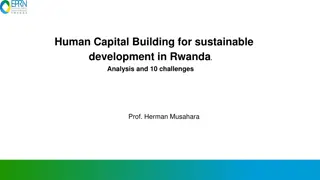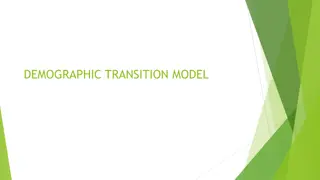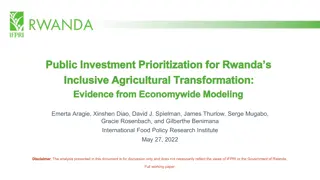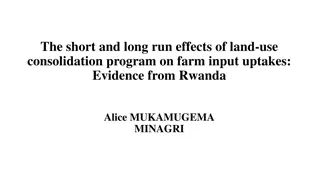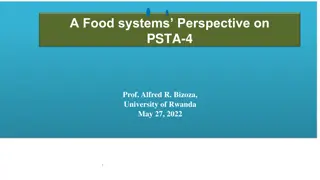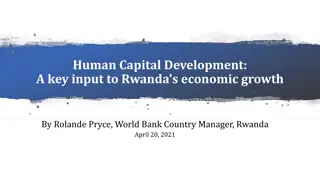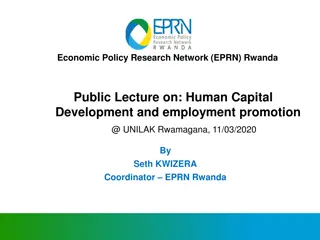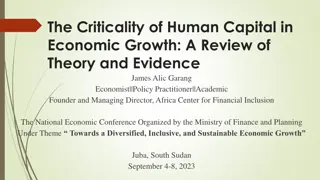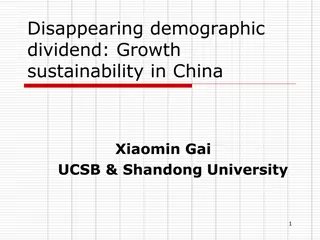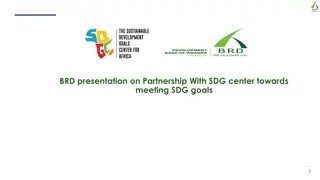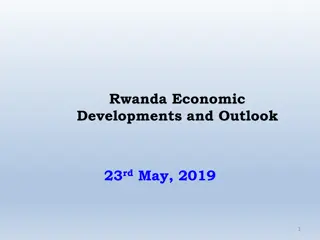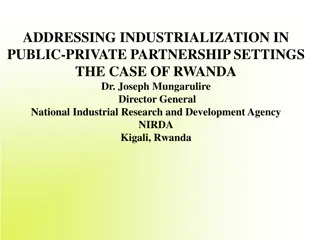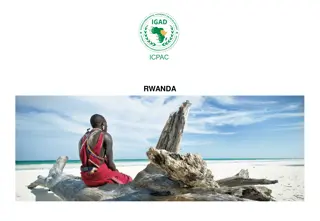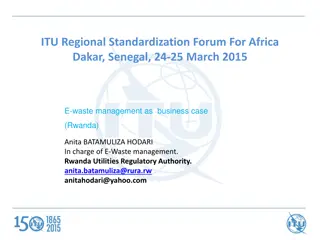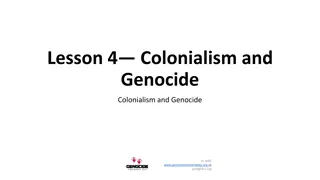Demographic Human Capital DGE Model for High-Growth Scenarios in Rwanda
This study focuses on a Demographic Human Capital Dynamic General Equilibrium (D-DGE) model for analyzing high-growth scenarios in Rwanda from 2016 to 2050. It explores the interactions of demographic dynamics, human capital, public infrastructure, and debt within a long-term growth framework. The model assesses the contributions of factors like human capital, infrastructure capital, and traditional growth elements, emphasizing the importance of education and health investments. By integrating these aspects, the model provides insights into enhancing productivity, economic growth, and social well-being in Rwanda.
Download Presentation

Please find below an Image/Link to download the presentation.
The content on the website is provided AS IS for your information and personal use only. It may not be sold, licensed, or shared on other websites without obtaining consent from the author. Download presentation by click this link. If you encounter any issues during the download, it is possible that the publisher has removed the file from their server.
E N D
Presentation Transcript
Demographic Human Capital DGE model for high-growth scenarios for Rwanda, 2016-50 futuRwa By Thierry Kalisa (MINECOFIN-Rwanda), Arend Kouwenaar (GIZ) The 6th EPRN Annual research conference Theme: Building Productive Capacities for Structural Economic Transformation
D-DGE Model for high-growth scenarios for Rwanda Rationale long-term growth model I. Model blocks Production function at center II. III. Specification Demographic Dynamic General Equilibrium model Demographic module Education and health modules DGE block, incl. public (infrastructure) capital Baseline and Policy scenarios: High-income 2018-50 IV. Conclusion: importance of comprehensive tool V. Human & public capital Population, capital and debt dynamics Ministry of Trade and Industry 2013 Economic Policy Research Network 2
I. Rationale/features Combine demographic, human/public capital and debt dynamics in DGE model for long-term growth scenarios Ground model in economic (growth) theory and provide practical application to underpin LT strategies (linked to Rwanda databases, other projection tools) Quantifygrowth contributions of factors: human capital (H), public (infrastructure) capital (Kpu), and traditional growth factors (K, L, La, TFP) Explore role of human/public capital produced by government (endogenous growth features): can raise levels of output, even if not the steady-state growth rates (in practice: a sequence of shifting steady states) Assesskey macro constraints and impact of alternative policies on growth, budget cost, and trade-offs between policy objectives Captureeducation and health: key to social protection schemes enhance productivity & growth, in addition to human well-being & social cohesion. 3 Ministry of Trade and Industry 2013 Economic Policy Research Network
II. Model blocks Demographic module D- projects population, age structure, participation rates, labor force L has simplified structure compared to full demographic models Education module producing Human education capital He links targets for education indicators to number of school years s produced and average education level of the work force links education level to education spending and to macro productivity Health module producing Human health capital Hh links targets for health coverage to life expectancy le of work force links health outcome to health spending and to macro productivity Economic block: DGE links growth, public investment Kpu, debt sustainability (post-HIPC scaling- up) macro production function, consumption, investment, capital inflows, debt, reflecting behavior, relative prices (real interest rate, real exchange rate) 4 Ministry of Trade and Industry 2013 Economic Policy Research Network
II. Macro production function ? ] ? = ?? [????? + ????]???? ? ? [? ..,??????? Y output (value added), Kcapital,L labor,La land ? = ???? + ???? human capital, s average number of completed years of schooling and lehealth (life expectancy) ? TFP determined by public capital, a trend and other variables ? .., ??????? ? output elasticity of public capital Ysector value added excluding government (treated separately) L labor force excl. govt workers(LGe, LGh,..)producing human capital return on public investment through project and sector Cost-Benefit Analysis 5 Ministry of Trade and Industry 2013 Economic Policy Research Network
II. Growth accounting past, 2000-16 . Real GDP Private capital Labor Education Health Land TFP o/w: public capital Govt Value added resi- dual share 0.25 Economy 1/ share 0.60 1.6 share 0.60 share 0.60 share 0.15 0.3 share 0.12 1.0 2000-2010 8.2 1.1 0.5 0.7 3.2 1.2 2.0 2010-2016 7.3 2.0 1.6 0.7 0.4 0.2 1.6 1.4 0.1 0.8 2000-2016 7.9 1.5 1.6 0.6 0.6 0.2 2.5 1.3 1.2 0.9 (6.7) (3.0) (1.0) (1.1) (1.8) (12.2) average growth in% (7.7) schooling life exp. average change in years p.y. 1.4 year 0.07 year 6 Ministry of Trade and Industry 2013 Economic Policy Research Network
III. Specification D-DGE model demographic block (example) 7 Ministry of Trade and Industry 2013 Economic Policy Research Network
III. Specification D-DGEeducation block 8 Ministry of Trade and Industry 2013 Economic Policy Research Network
III. Specification D-DGEeducation block Education targets and inputs ??????? ???? ???????,? ???????????](3a) ???= ?[??????????????????????,??????????,??????????, ????????= ?[?????? ? ?; ?1;?????????? ???,?2 ;? ?; ?3] (3b) where:??? ??? ?1, ?2 , ?3 y l number of teachers, given target enrollment rate, student/teacher ratio salary cost per teacher passthrough coefficients growth rate labor productivity of the economy ???????? = ???????? / ?????????????? ?????????? (3c) ??= ?? 11 ????+ ???????? (3d) number of schooling years embodied in the population (s average) schooling depreciation rate number of schooling years produced enrollment, completion rates, student-teacher ratio where: ?? ?? ???????? parameters 9 Ministry of Trade and Industry 2013 Economic Policy Research Network
III. D-DGEeducation block: illustration . 10 Ministry of Trade and Industry 2013 Economic Policy Research Network
III. D-DGEeducation block: illustration . 11 Ministry of Trade and Industry 2013 Economic Policy Research Network
III. D-DGE modelhealth block 12 Ministry of Trade and Industry 2013 Economic Policy Research Network
III. Demographic DGE modelhealth block 13 Ministry of Trade and Industry 2013 Economic Policy Research Network
III. D-DGE model: main economic blocks Production/supply (one sector) - Cobb Douglas (cf. growth accounting), see slide 5 - Output is split between (Non)Tradables in CET function of RER (external block); T are 40% of output in 2016 (exports, consumption import substitutes) Demand: private savings and consumption - Savings is a function of per capita disposable income (after tax and external factor payments, transfers), determines national savings - Parameters are semi-elasticities vis- -vis p.c. income, real interest rate (deposits, RIR), share of EAP in population, positive, increasing in pc income Demand: private investment - Private investment follows from dynamic optimization: desired investment is function of Marginal Product of Capital (MPK) relative to cost of capital: real interest rate (RIR) plus depreciation ( ), and adjustment costs - Investment curve downward-sloped in RIR and its level determined by past productivity of capital, as influenced by public capital (Kpu)and TFP 14 Ministry of Trade and Industry 2013 Economic Policy Research Network
III. DGE model: main economic blocks Private capital inflows - Capital inflows are positive function of foreign-domestic RIR differential subject to capital mobility parameter - Foreign interest rate includes risk premium which declines with country reputation but increases as stock of foreign capital (debt, FDI) increases Savings-investment equilibrium - Private national savings & private capital inflows both upward-sloping in RIR, and investment demand downward-sloping, determine equilibrium by variation in RIR, after deduction of government net debt issuance - An upward shift in investment demand e.g., as MPK increases thanks to government investment raises interest rates, inducing higher domestic savings and capital inflows - An increase in government domestic borrowing reduces net supply of domestic savings, raising interest rate and depressing private investment 15 Ministry of Trade and Industry 2013 Economic Policy Research Network
III. DGE model: main economic blocks ???= ???( 1)1 ???+???? (1 ??) (13a) with 0 ?? 1 where: ??? depreciation rate and ?? inefficiency of public investment ????=????? / ?????? price of government investment (13b) 16 Ministry of Trade and Industry 2013 Economic Policy Research Network
III. DGE model: main economic blocks Supply and demand for tradables Supply of tradables is determined as share of total output according to CET function of relative prices (RER) Demand for tradables is based on CES functions, shares in demand being functions of RER, for each demand category i(consumption, investment) External equilibrium With net supply of tradables increasing function of RER and private capital inflows increasing function of domestic RIR (minus expected RER depreciation), external equilibrium is obtained through variation of RER Dynamic equations update factor supplies and debt stocks Each factor is updated each period based on private investment, labor supply, human capital, public investment, land, Similarly for public & private debt stocks, including RER valuation change this completes the D-DGE specification 17 Ministry of Trade and Industry 2013 Economic Policy Research Network
IV. Policy scenarios: High-income 2050 18 Ministry of Trade and Industry 2013 Economic Policy Research Network
IV. Policy scenarios: High-income 2050 - Growth accelerating policies 19 Ministry of Trade and Industry 2013 Economic Policy Research Network
IV. Policy scenarios: High-income 2050 20 Ministry of Trade and Industry 2013 Economic Policy Research Network
IV. Policy scenarios: High-income 2050 Fiscal policies - Higher public spending on human capital (plus 2.5-3.0% of GDP) - Higher spending on public teachers and health workers producing human capital also boosts government direct contribution to growth - Public investment to 11 % of GDP in 2030-35, stabilizing at 11% after - Higher spending in part matched by more government adjusted savings (excl. human capital spending) - Fiscal deficits around 5 % of GDP, continued reliance on foreign concessional borrowing - Domestic financing kept low: avoiding crowding out private investment; absorbing fluctuations in external flows (stock kept below 5% of GDP) 21 Ministry of Trade and Industry 2013 Economic Policy Research Network
IV. Policy scenarios: High-income 2050 Fiscal policies education spending Human capital in education is driven by public policies to improve enrollment, completion, quality, teacher salaries etc. produce more completed schooling years and increase average level of education Public education spending up from 3.8% in 2016 to almost 6% of GDP by 2030, in line with rising enrollment targets and teacher real salaries (just below growth of economy-wide output per worker), and declines thereafter as school-age population slows A large part of the spending increase is from tertiary gross enrollment doubling to 16% between 2016 and 2050 (MINEDUC projections), with share of public provision kept unchanged (at below 50%) 22 Ministry of Trade and Industry 2013 Economic Policy Research Network
IV. Policy scenarios: High-income 2050 . 23 Ministry of Trade and Industry 2013 Economic Policy Research Network
IV. Policy scenarios: High-income 2050 Fiscal policies health spending Human capital in health is driven by policies to continuously improve coverage by health services, to a large extent remaining public, on efficiency and equity grounds Public health spending up from 2.8% of GDP in 2016 to 4.8% of GDP by 2050, reflecting rising health coverage and increasing costs per health worker (just below growth of economy-wide output per worker) Combination of the two rising trends means that public health spending keeps going up in percent of GDP Large increase in per capita spending in constant US$ (WHO norm) Projected path depends crucially on share of public provision: assumed to decline from 97% in 2016 to 70% by 2030 and stay at that level thereafter 24 Ministry of Trade and Industry 2013 Economic Policy Research Network
V. D-DGE model for Rwanda: conclusion Growth of 11% py is feasible albeit ambitious, with: stepped- up investment in HC & public capital (incl. land); private savings mobilization; and sustained reliance on foreign borrowing on favorable terms Sizable growth contributions from those factors would leave a realistic 2 % to come from TFP, enabled by the trio human, public capital and openness 25 Ministry of Trade and Industry 2013 Economic Policy Research Network
V. D-DGE MODEL FOR RWANDA: CONCLUSION Returns on alternative policies education: gains in average schooling of EAP has high macro growth effect and highest rate of return on investment health: gains in health worker coverage and life expectancy has a bit lower returns, as life expectancy gains have been already substantial investment in public capital has high macro growth effect, and rates of return well above cost of borrowing; highest return: improving investment efficiency savings: measures to encourage saving, improve financial intermediation and efficiency (reducing spread) have relatively low costs and high macro growth effect via private investment openness: DFI/private inflows allow faster growth of capital (& TFP gains), but trade-off with RER depreciation (& associated TFP gains in tradables) 26 Ministry of Trade and Industry 2013 Economic Policy Research Network
V. D-DGE model for Rwanda: conclusion Comprehensive tool to underpin long-term strategies combining demography, human/physical capital with DGE, founded in theory quantifying macro constraints and trade-offs between policies Capturing part of social protection human capital assessing growth impact & costs of access to education & health services produced human capital lifts output levels, but with diminishing returns not growth rates,but exogenous TFP growth is marked up by HC investment human capital joint with public capital/innovation policies likely fosters TFP need for HC expertise to capture this complexity Capturing public capital-growth-debt sustainability assessing growth impact of public capital ( output-Kpu elasticity, 0.13), complementary to private factors; need for project/sector CBA to assess DGE analyzes trade offs: ex. between Kpu-enabled growth and debt 27 Ministry of Trade and Industry 2013 Economic Policy Research Network





